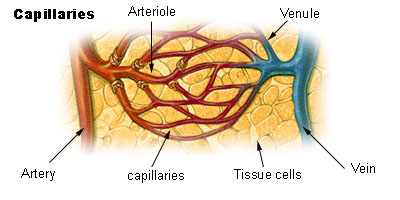
Figure showing capillaries as the transition between arteries and veins
http://en.wikipedia.org/wiki/File:Illu_capillary.jpg
Interactive diagram illustrating arterial and venous structure.
http://www.phschool.com/science/biology_place/biocoach/cardio2/structure.html

Figure
Shows the how valves cause blood to only flow one way though veins
http://upload.wikimedia.org/wikipedia/commons/thumb/4/4a/Venous_valve.svg
/2000px-Venous_valve.svg.png
Capillaries
- Capillaries are little more than a single layer or endothelial cells.
- Capillaries form intricate networks throughout the tissues.
- They allow water, nutrients and gasses to diffuse out of the blood and waste
materials to diffuse into the blood.
- This exchange occurs between the blood and the interstitial fluid.
- The interstitial fluid is the fluid surrounding the cells.
- The blood never comes into contact with the cells.
- The blood and interstitial fluid exchange material, and the interstitial fluid
then exchanges material with the cells.
Veins
- The intricate networks formed by the capillaries eventually converge to form
venules, (small veins)
- The venules then converge to form veins which return the blood to the heart.
- Veins only consist of two layers.
- The outer layer is made up of connective tissue
- The inner layer is made up of endothelial cells.
Valves
- Once the blood has passed through the capillaries very little blood pressure
remains to return blood to the heart.
- Instead of pressure from the heart veins use a series of valves to force blood
to return to the heart.
- Contraction of the muscles squeezes the veins, pushing the blood through them.
- The valves cause the blood to flow in only one direction, back to the heart.

Figure showing capillaries as the transition between arteries and veins
http://en.wikipedia.org/wiki/File:Illu_capillary.jpg
Interactive diagram illustrating arterial and venous structure.
http://www.phschool.com/science/biology_place/biocoach/cardio2/structure.html

Figure
Shows the how valves cause blood to only flow one way though veins
http://upload.wikimedia.org/wikipedia/commons/thumb/4/4a/Venous_valve.svg
/2000px-Venous_valve.svg.png
Veins
- The intricate networks formed by the capillaries eventually converge to form
venules, (small veins)
- The venules then converge to form veins which return the blood to the heart.
- Veins only consist of two layers.
- The outer layer is made up of connective tissue
- The inner layer is made up of endothelial cells.
Valves
- Once the blood has passed through the capillaries very little blood pressure
remains to return blood to the heart.
- Instead of pressure from the heart veins use a series of valves to force blood
to return to the heart.
- Contraction of the muscles squeezes the veins, pushing the blood through them.
- The valves cause the blood to flow in only one direction, back to the heart.

Figure showing capillaries as the transition between arteries and veins
http://en.wikipedia.org/wiki/File:Illu_capillary.jpg
Interactive diagram illustrating arterial and venous structure.
http://www.phschool.com/science/biology_place/biocoach/cardio2/structure.html





